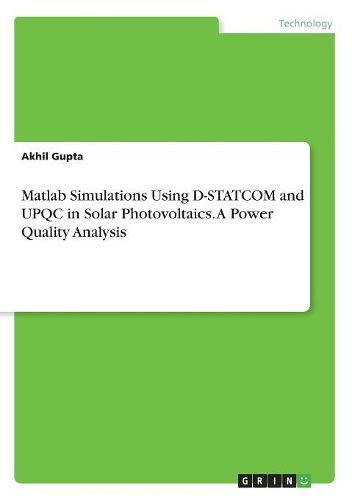Readings Newsletter
Become a Readings Member to make your shopping experience even easier.
Sign in or sign up for free!
You’re not far away from qualifying for FREE standard shipping within Australia
You’ve qualified for FREE standard shipping within Australia
The cart is loading…






Document from the year 2019 in the subject Energy Sciences, I. K. Gujral Punjab Technical University, course: Electrical Engineering, language: English, abstract: India's plan to ramp up solar power generation to 100 GW by 2022 is among the largest in the world. It aims to bring sustainable, clean, climate-friendly electricity to millions of India's people. The World Bank Group is moving to help India deliver on its unprecedented plans to scale up solar energy from installing solar panels on rooftops to setting up massive solar parks. This will catapult India to the forefront of the global effort to bring electricity to all, mitigate the effects of climate change, and set the country on a path to become the India of the future. Solar power in India is a fast-developing industry, with a cumulative installed grid connected solar power capacity of 26,025.97 MW (26 GW) as of 31st December 2019. The Indian government has significantly expanded its solar plans, targeting 100 billion US dollar of investment and 100 GW of solar capacity (including 40 GW from rooftop solar) by 2022. This book presents the status of renewable energy and solar PV technology at the beginning. A solar Photovoltaic (PV) cell converts solar radiation into electric energy with the help of a diode, two resistances and connected load. In order to harness the maximum power, Maximum Power Point Tracking (MPPT) technique is used which is able to generate the power at Maximum Power point (MPP). The importance of two custom power devices namely, Distributed Static Compensator (D-STATCOM) and Unified Power Quality Conditioner (UPQC) is highlighted with its impact on Power Quality (PQ) especially considering various PQ issues. In this book, the impact of three-phase fault at unity power on the performance of solar PV grid tied system is highlighted. The PQ system performance has been evaluated under the influence of three-phase fault and waveforms are studied. The effect of fault has been discussed at Po
$9.00 standard shipping within Australia
FREE standard shipping within Australia for orders over $100.00
Express & International shipping calculated at checkout
Document from the year 2019 in the subject Energy Sciences, I. K. Gujral Punjab Technical University, course: Electrical Engineering, language: English, abstract: India's plan to ramp up solar power generation to 100 GW by 2022 is among the largest in the world. It aims to bring sustainable, clean, climate-friendly electricity to millions of India's people. The World Bank Group is moving to help India deliver on its unprecedented plans to scale up solar energy from installing solar panels on rooftops to setting up massive solar parks. This will catapult India to the forefront of the global effort to bring electricity to all, mitigate the effects of climate change, and set the country on a path to become the India of the future. Solar power in India is a fast-developing industry, with a cumulative installed grid connected solar power capacity of 26,025.97 MW (26 GW) as of 31st December 2019. The Indian government has significantly expanded its solar plans, targeting 100 billion US dollar of investment and 100 GW of solar capacity (including 40 GW from rooftop solar) by 2022. This book presents the status of renewable energy and solar PV technology at the beginning. A solar Photovoltaic (PV) cell converts solar radiation into electric energy with the help of a diode, two resistances and connected load. In order to harness the maximum power, Maximum Power Point Tracking (MPPT) technique is used which is able to generate the power at Maximum Power point (MPP). The importance of two custom power devices namely, Distributed Static Compensator (D-STATCOM) and Unified Power Quality Conditioner (UPQC) is highlighted with its impact on Power Quality (PQ) especially considering various PQ issues. In this book, the impact of three-phase fault at unity power on the performance of solar PV grid tied system is highlighted. The PQ system performance has been evaluated under the influence of three-phase fault and waveforms are studied. The effect of fault has been discussed at Po